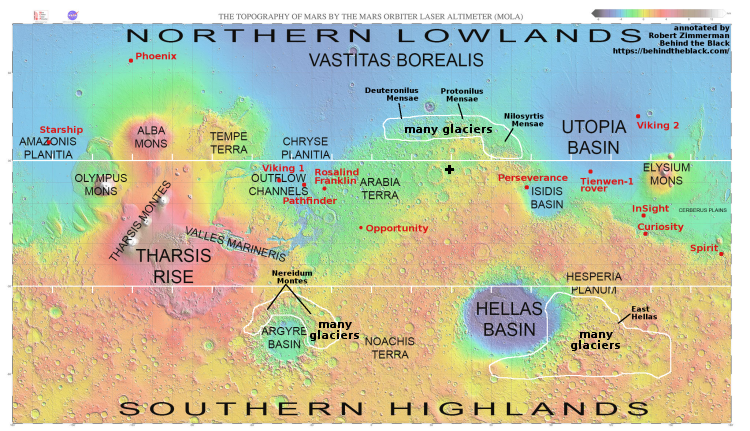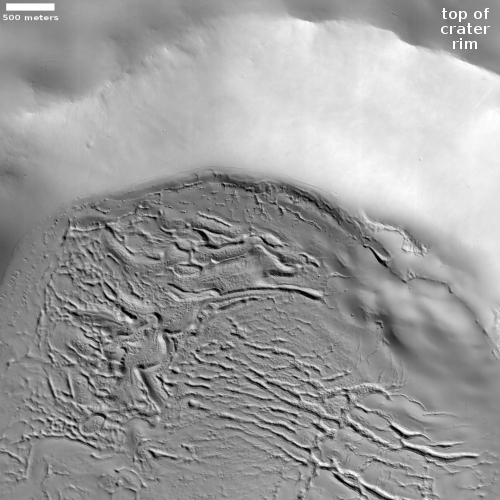Ice in the Martian equatorial region?

Today’s cool image to the right, rotated, cropped, and reduced to post here, is actually an older captioned image, published in 2017 by the science team for the high resolution camera on Mars Reconnaissance Orbiter (MRO). I missed its significance when it was first released. From the caption by Alfred McEwen of the Lunar & Planetary Laboratory in Arizona:
The material on the floor of this crater appears to have flowed like ice, and contains pits that might result from sublimation of subsurface ice. The surface is entirely dust-covered today. There probably was ice here sometime in the past, but could it persist at some depth?
This crater is at latitude 26 degrees north, and near-surface ice at this latitude (rather than further toward one of the poles) could be a valuable resource for future human exploration.
As shown in the global map of Mars above, this 26-mile-wide unnamed crater, marked by the black cross, is well inside the equatorial region 30 degrees north and south from the equator where almost no evidence of near surface ice has been found. Whenever I look at an image from MRO, if the picture appears to show ice or glacial features, its latitude is always 30 degrees or higher. If it does not, it is almost always in this equatorial region.
This crater however shows evidence of glacial features in its interior, but is far closer to the equator than normal. How could this be? It is possible that its high altitude, sitting in the southern cratered highlands, might have helped preserve its buried but near surface glacial features.
Regardless, as McEwen notes, its location closer to the equator is tantalizing, because it suggests that such ice could exist even in the equatorial regions, though buried and thus not detected by the instruments presently available in Mars orbit.
On Christmas Eve 1968 three Americans became the first humans to visit another world. What they did to celebrate was unexpected and profound, and will be remembered throughout all human history. Genesis: the Story of Apollo 8, Robert Zimmerman's classic history of humanity's first journey to another world, tells that story, and it is now available as both an ebook and an audiobook, both with a foreword by Valerie Anders and a new introduction by Robert Zimmerman.
The print edition can be purchased at Amazon or from any other book seller. If you want an autographed copy the price is $60 for the hardback and $45 for the paperback, plus $8 shipping for each. Go here for purchasing details. The ebook is available everywhere for $5.99 (before discount) at amazon, or direct from my ebook publisher, ebookit. If you buy it from ebookit you don't support the big tech companies and the author gets a bigger cut much sooner.
The audiobook is also available at all these vendors, and is also free with a 30-day trial membership to Audible.
"Not simply about one mission, [Genesis] is also the history of America's quest for the moon... Zimmerman has done a masterful job of tying disparate events together into a solid account of one of America's greatest human triumphs."--San Antonio Express-News

Today’s cool image to the right, rotated, cropped, and reduced to post here, is actually an older captioned image, published in 2017 by the science team for the high resolution camera on Mars Reconnaissance Orbiter (MRO). I missed its significance when it was first released. From the caption by Alfred McEwen of the Lunar & Planetary Laboratory in Arizona:
The material on the floor of this crater appears to have flowed like ice, and contains pits that might result from sublimation of subsurface ice. The surface is entirely dust-covered today. There probably was ice here sometime in the past, but could it persist at some depth?
This crater is at latitude 26 degrees north, and near-surface ice at this latitude (rather than further toward one of the poles) could be a valuable resource for future human exploration.
As shown in the global map of Mars above, this 26-mile-wide unnamed crater, marked by the black cross, is well inside the equatorial region 30 degrees north and south from the equator where almost no evidence of near surface ice has been found. Whenever I look at an image from MRO, if the picture appears to show ice or glacial features, its latitude is always 30 degrees or higher. If it does not, it is almost always in this equatorial region.
This crater however shows evidence of glacial features in its interior, but is far closer to the equator than normal. How could this be? It is possible that its high altitude, sitting in the southern cratered highlands, might have helped preserve its buried but near surface glacial features.
Regardless, as McEwen notes, its location closer to the equator is tantalizing, because it suggests that such ice could exist even in the equatorial regions, though buried and thus not detected by the instruments presently available in Mars orbit.
On Christmas Eve 1968 three Americans became the first humans to visit another world. What they did to celebrate was unexpected and profound, and will be remembered throughout all human history. Genesis: the Story of Apollo 8, Robert Zimmerman's classic history of humanity's first journey to another world, tells that story, and it is now available as both an ebook and an audiobook, both with a foreword by Valerie Anders and a new introduction by Robert Zimmerman.
The print edition can be purchased at Amazon or from any other book seller. If you want an autographed copy the price is $60 for the hardback and $45 for the paperback, plus $8 shipping for each. Go here for purchasing details. The ebook is available everywhere for $5.99 (before discount) at amazon, or direct from my ebook publisher, ebookit. If you buy it from ebookit you don't support the big tech companies and the author gets a bigger cut much sooner.
The audiobook is also available at all these vendors, and is also free with a 30-day trial membership to Audible.
"Not simply about one mission, [Genesis] is also the history of America's quest for the moon... Zimmerman has done a masterful job of tying disparate events together into a solid account of one of America's greatest human triumphs."--San Antonio Express-News


